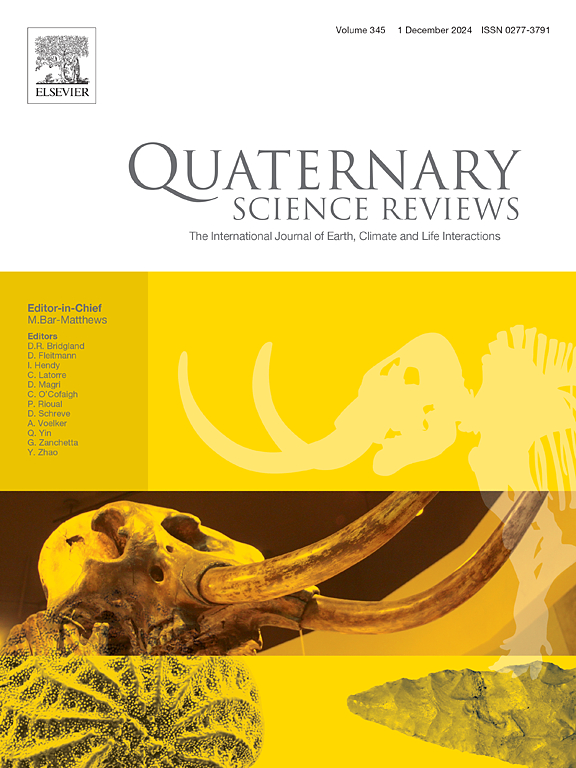Not by chemistry alone: Tephrostratigraphy, correlation, and context at two Palaeolithic sites in the southern Caucasus and Armenian Highlands
IF 3.2
1区 地球科学
Q1 GEOGRAPHY, PHYSICAL
引用次数: 0
Abstract
Understanding the timing of Late Pleistocene population expansions and interactions is hindered by myriad factors among which the imprecision of absolute dating is of particular concern. The identification and geochemical characterization of cryptically preserved volcanic ash layers (cryptotephra) in archaeological sites can alleviate this problem, and in the southern Caucasus and Armenian Highlands has allowed for the correlation of lithostratigraphic units at Palaeolithic sites in the two geographic regions. Compositionally distinct tephras (isochrons) allow specific stratigraphic layers to be linked temporally at the sites of Ortvale Klde (OK, Georgia) and Lusakert-1 (LKT-1, Armenia). The ∼30 ka V-18/Nemrut Formation tephra from the Nemrut volcano, eastern Türkiye is correlated with an Upper Palaeolithic layer at OK and a Late Middle Palaeolithic layer at LKT-1. This isochron suggests the long-term regional coexistence of technologically distinct populations, and the late survival of Late Middle Palaeolithic hominins. These results appear to capture a critical and until now elusive moment in hominin evolution, a period when two distinct tool-making groups, generally assumed to be Homo sapiens and Neanderthals, occupied the same region and likely interacted. However, careful comparison of results with site-specific sedimentological, taphonomic, archaeological, and chronometric data throw these correlations into question. Closer consideration of newly available glass geochemistry for Nemrut suggests further correlations: OK Layer 4c correlates to the V-30 tephra in Lake Van (∼42–37 ka); LKT-1 Lithostratigraphic Unit (LU) 4 correlates to both the ∼60 ka V-45/Çekmece and ∼62 ka V-51/Ahlat Pumice 6; and the younger LKT-1 LU 3 also correlates to the V-51, but with a different compositional range to those seen in the older LU 4. The only way to reconcile the range of compositions observed is that there are additional Nemrut eruptions that have similar glass chemistries to the deposits characterized, and that our current understanding of Nemrut's eruption stratigraphy is incomplete thus hampering our ability to resolve the age(s) of these distal tephra deposits with confidence. Therefore, while the analysis of cryptotephra holds great promise for understanding the timing of key evolutionary events, its application in the southern Caucasus and Armenian Highlands, and elsewhere, must be predicated on the careful consideration of site-specific contextual data rather than chemistry alone.
不仅仅是化学:在南高加索和亚美尼亚高地的两个旧石器时代遗址的地层、对比和背景
了解晚更新世种群扩张和相互作用的时间受到无数因素的阻碍,其中绝对年代测定的不精确性尤其值得关注。考古遗址中神秘保存的火山灰层(隐层)的鉴定和地球化学特征可以缓解这一问题,并且在南高加索和亚美尼亚高地,可以在两个地理区域的旧石器时代遗址中进行岩石地层单位的对比。在Ortvale Klde (OK, Georgia)和Lusakert-1 (LKT-1, Armenia)的遗址上,不同成分的层序(等时线)允许将特定的地层在时间上联系起来。 rkiye东部Nemrut火山的~ 30 ka V-18/Nemrut组tephra与OK的上旧石器时代层和LKT-1的中晚期旧石器时代层相对应。这条等时线表明,在技术上不同的种群在区域内长期共存,以及旧石器时代晚期中期人类的晚期生存。这些结果似乎抓住了人类进化中一个关键的、直到现在还难以捉摸的时刻,在这个时期,两个不同的制造工具的群体,通常被认为是智人和尼安德特人,占据了同一地区,并可能相互作用。然而,将结果与特定地点的沉积学、地貌学、考古学和年代学数据进行仔细比较,会使这些相关性受到质疑。对Nemrut新发现的玻璃地球化学的进一步考虑表明了进一步的相关性:OK 4c层与Van湖(~ 42-37 ka)的V-30 tephra相关;LKT-1岩石地层单元(LU) 4与~ 60 ka V-45/Çekmece和~ 62 ka V-51/Ahlat浮石6相关;而较年轻的LKT-1 LU 3也与V-51相关,但与较老的LU 4中看到的成分范围不同。唯一能够调和所观察到的成分范围的方法是,还有其他的内姆鲁特火山喷发与所描述的沉积物具有相似的玻璃化学成分,而且我们目前对内姆鲁特火山喷发地层学的了解是不完整的,因此阻碍了我们确定这些远端tephra沉积物年龄的能力。因此,虽然对隐隐菌的分析对理解关键进化事件的时间有很大的希望,但它在南高加索和亚美尼亚高地以及其他地方的应用,必须基于对特定地点背景数据的仔细考虑,而不仅仅是化学。
本文章由计算机程序翻译,如有差异,请以英文原文为准。
求助全文
约1分钟内获得全文
求助全文
来源期刊

Quaternary Science Reviews
地学-地球科学综合
CiteScore
7.50
自引率
15.00%
发文量
388
审稿时长
3 months
期刊介绍:
Quaternary Science Reviews caters for all aspects of Quaternary science, and includes, for example, geology, geomorphology, geography, archaeology, soil science, palaeobotany, palaeontology, palaeoclimatology and the full range of applicable dating methods. The dividing line between what constitutes the review paper and one which contains new original data is not easy to establish, so QSR also publishes papers with new data especially if these perform a review function. All the Quaternary sciences are changing rapidly and subject to re-evaluation as the pace of discovery quickens; thus the diverse but comprehensive role of Quaternary Science Reviews keeps readers abreast of the wider issues relating to new developments in the field.
 求助内容:
求助内容: 应助结果提醒方式:
应助结果提醒方式:


